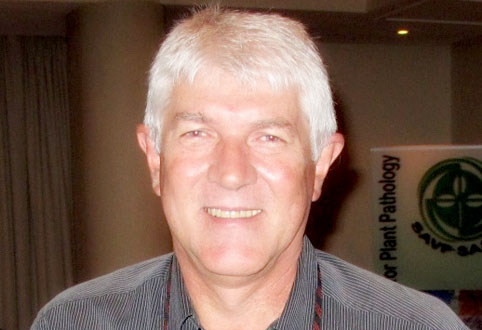 |
|
Prof. Zakkie Pretorius, professor in Plant Pathology in the Department of Plant Sciences at our university
|
Research by Zakkie Pretorius, professor in Plant Pathology in the Department of Plant Sciences at our university, has become part of Phase II of a mayor global project to combat deadly strains of a wheat pathogen that poses a threat to global food security.
Prof. Pretorius focuses on the identification of resistance in wheat to the stem rust disease and will assist breeders and geneticists in the accurate phenotyping of international breeding lines and mapping populations. In addition, Prof. Pretorius will support scientists from Africa with critical skills development through training programmes. During Phase I, which ends in 2011, he was involved in pathogen surveillance in Southern Africa and South Asia.
The Department of International Development (DFID) in the United Kingdom and the Bill and Melinda Gates Foundation will invest $40 million over the next five years in the global project led by the Cornell University. The project is aimed at combating deadly strains of Ug99, an evolving wheat pathogen that is a dangerous threat to global food security, especially in the poorest nations.
The Cornell University said in a statement, the grant made to the Durable Rust Resistance in Wheat (DRRW) project at Cornell will support efforts to identify new stem-rust resistant genes in wheat, improve surveillance, and multiply and distribute rust-resistant wheat seed to farmers and their families.
Researchers worldwide will be able to play an increasingly vital role in protecting wheat fields from dangerous new forms of stem rust, particularly in countries whose people can ill afford the economic impact of damage to this vital crop.
The Ug99 strain was discovered in Kenya in 1998, but are now also threatening major wheat-growing areas of Southern and Eastern Africa, the Central Asian Republics, the Caucasus, the Indian subcontinent, South America, Australia and North America.
Prof. Pretorius was responsible for the first description of this strain in 1999.
Among Cornell’s partners are national research centres in Kenya and Ethiopia, and scientists at two international agricultural research centres that focus on wheat, the Mexico-based International Maize and Wheat Improvement Center (known by its Spanish acronym as CIMMYT), and the International Center for Agricultural Research in the Dry Areas (ICARDA), in Syria. Advanced research laboratories in the United States, Canada, China, Australia, Denmark and South Africa also collaborate on the project. The DRRW project now involves more than 20 leading universities and research institutes throughout the world, and scientists and farmers from more than 40 countries.
Media Release
28 March 2011
Issued by: Lacea Loader
Director: Strategic Communication
Tel: 051 401 2584
Cell: 083 645 2454
E-mail: news@ufs.ac.za